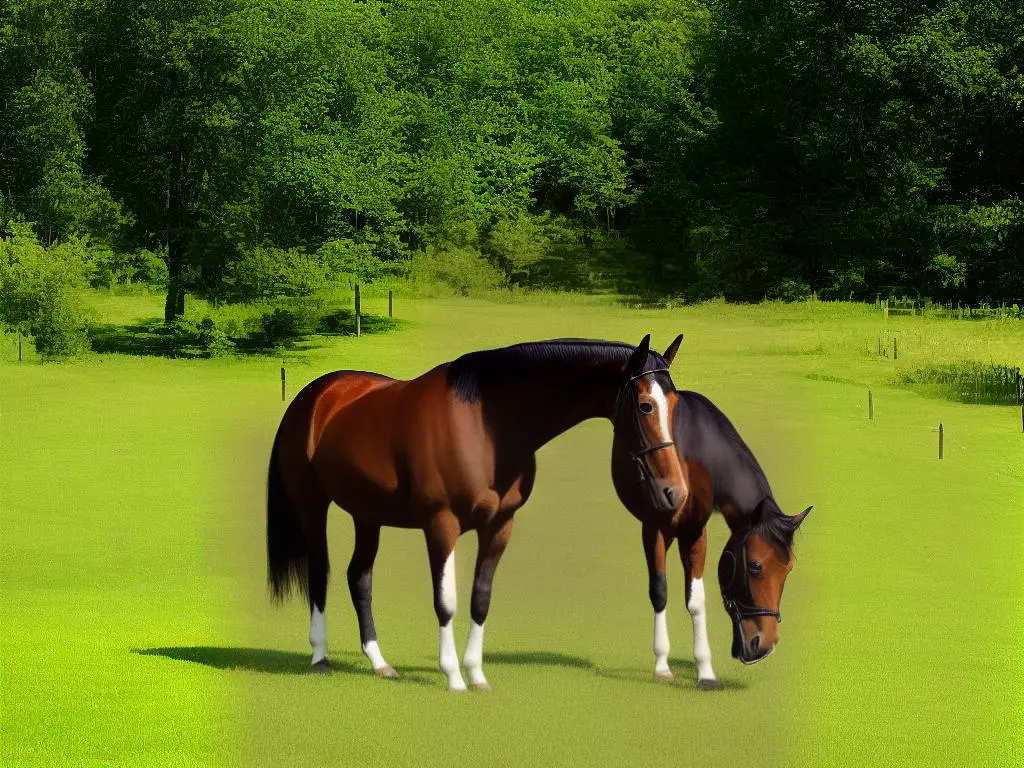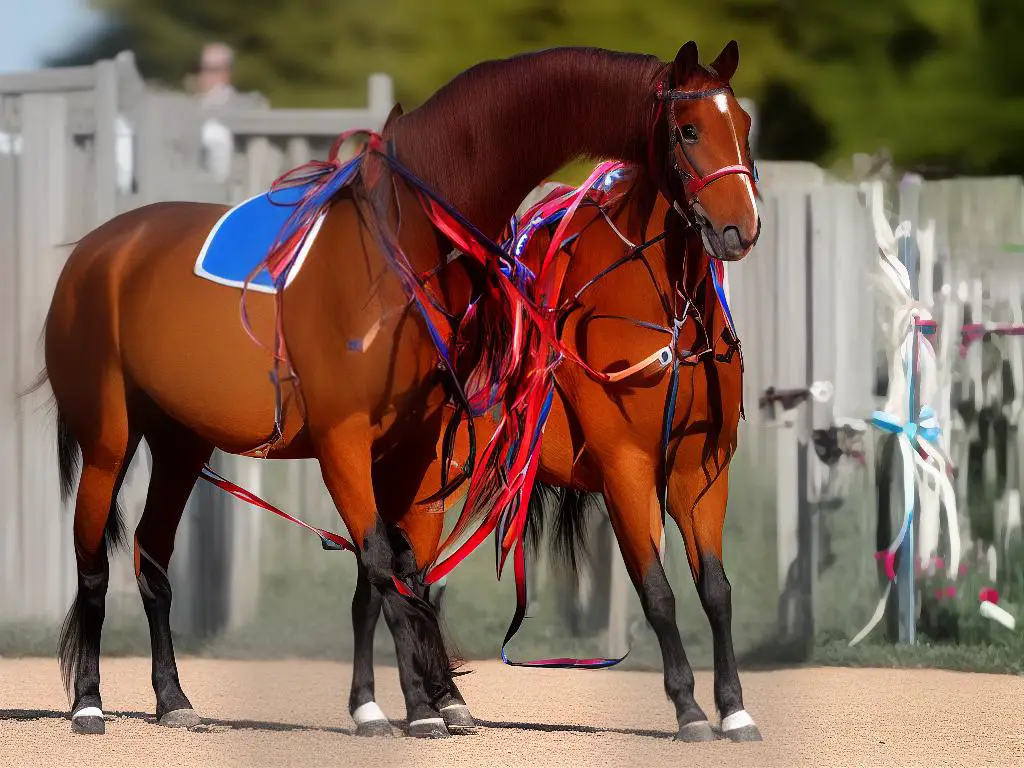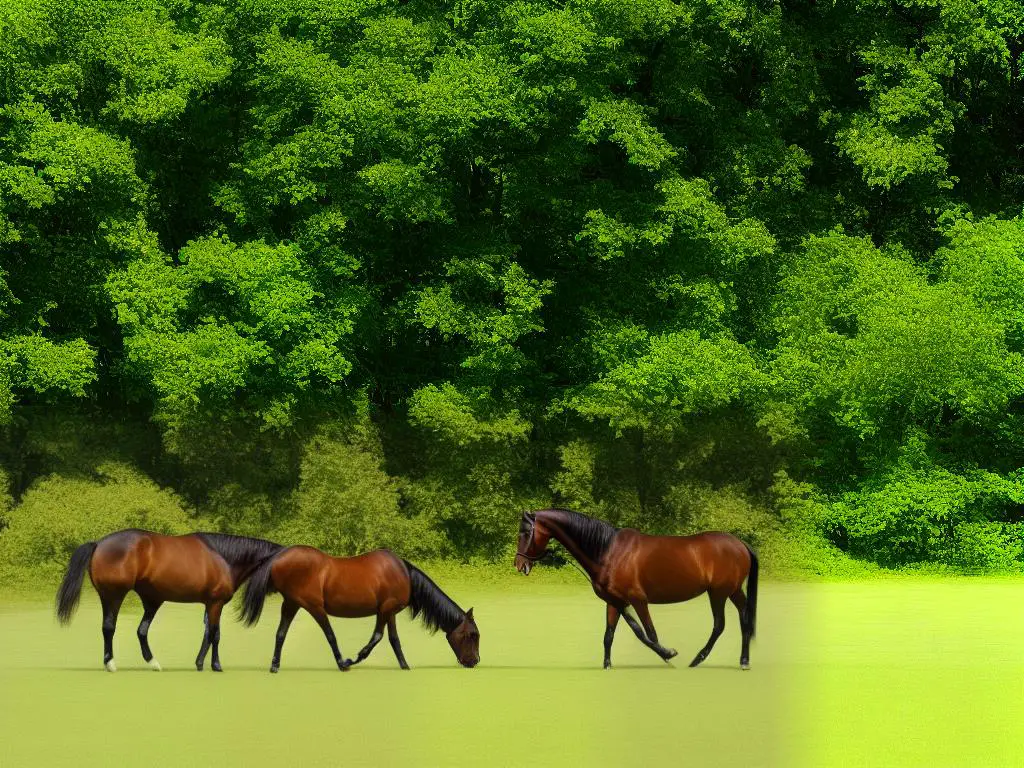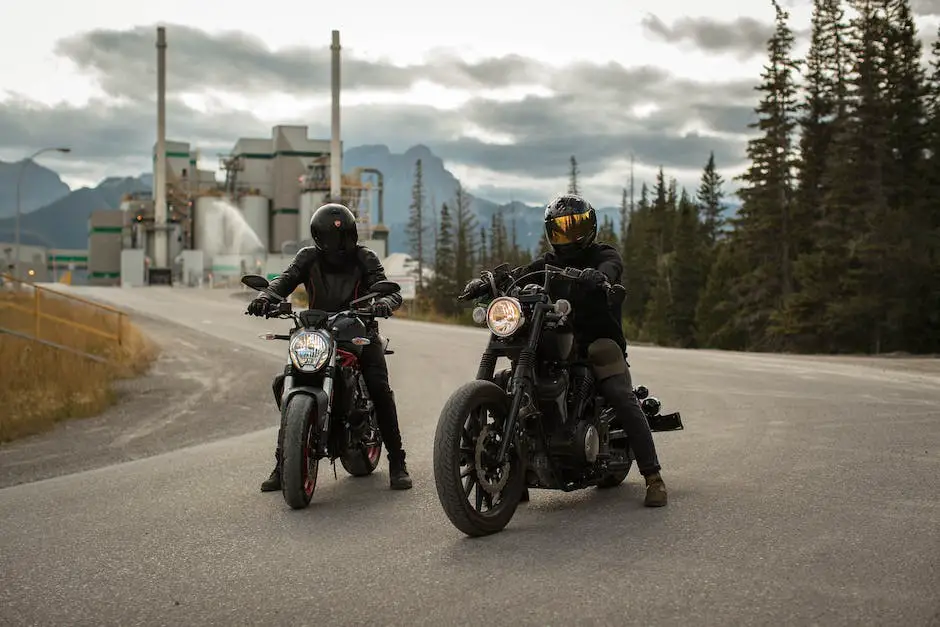The Kentucky Saddler, a remarkable horse breed that has played a significant role in American history and equestrian culture, continues to capture the hearts and admiration of enthusiasts and hobbyists alike. With its elegant movements, gentle temperament, and incredible versatility, it is no wonder that this breed has stood the test of time and remains an icon in the equestrian world. This exploration into the fascinating world of Kentucky Saddlers delves into its rich history, legendary equine figures, breeding practices, training techniques, and care and maintenance, ultimately revealing the magic behind this extraordinary breed.
Table of Contents (Horspedia)
History of Kentucky Saddlers
The Kentucky Saddler, also known as the American Saddlebred, is a horse breed that originated in Kentucky in the early 1800s. Its ancestry can be traced back to British saddle horses…
During the American Civil War, Kentucky Saddlers played a significant role as both cavalry and officer’s mounts…
In an effort to preserve and promote the breed, the Kentucky Saddler Breeders’ Association was established in 1891…
Famous Kentucky Saddlers have contributed significantly to the history of American horse breeding…
As an enthusiast or hobbyist, the Kentucky Saddler, primarily known for their stunning performance in saddle seat competitions, holds a special place in America’s equine history.

Notable Kentucky Saddlers
The Kentucky Saddler, also known as the American Saddlebred, boasts a rich and fascinating lineage that traces back to the early 1800s. Hailing from the picturesque Bluegrass region of Kentucky, these elegant and versatile horses swiftly garnered a reputation for their smooth gaits, intelligence, and unparalleled athleticism. Over the years, various famous Kentucky Saddlers have emerged, each playing a crucial role in the breed’s development and success. Showcasing their impressive capabilities, these horses have excelled across diverse disciplines, such as dressage, show jumping, and pleasure riding.One prime example of an exceptional Kentucky Saddler is the legendary Rex McDonald. Foaled in 1890, Rex McDonald was an exquisite chestnut stallion with a perfect blend of grace and power. Bred by Sam McDonald and owned by William L. Barclay, he was sired by Rex Denmark, another influential stallion in the breed’s history. Throughout his career, Rex McDonald earned countless championships at prestigious shows such as the St. Louis Fair, the Kentucky State Fair, and the World’s Columbian Exposition in Chicago. His contributions to the breed were immense, as many American Saddlebreds today trace their lineage back to Rex McDonald.In the mid-20th century, another iconic Kentucky Saddler emerged by the name of Wing Commander. Born in 1943, Wing Commander was a stunning and charismatic chestnut stallion that captivated the entire horse world with his extraordinary performances. Sired by Anacacho Shamrock and out of Flirtation Walk, Wing Commander was known for his incomparable high-stepping trot, impeccable form, and electrifying presence in the show ring. With Earl Teater as his trainer, he became the first horse to win six consecutive World’s Grand Championships in the Five-Gaited division from 1948-1953. Today, Wing Commander’s legacy lives on through his descendants, including many champions and influential breeding stallions.Another notable Kentucky Saddler worth mentioning is Bourbon King. Foaled in 1900, Bourbon King was an influential sire with a notable pedigree. His sire was the esteemed stallion, Bourbon Chief, and his dam was the beautiful mare, Annie C. Although Bourbon King did not have a show ring career, he was hugely successful in the breeding barn, producing numerous outstanding offspring. His progeny included Edna May, Queen of the Tropics, King’s Genius, and the renowned stallion Kalarama Rex. Through his descendants, Bourbon King played a pivotal role in forming the modern American Saddlebred breed.
In recent history, one famous Kentucky Saddler that has left a significant impact on the breed is CH Gypsy Supreme. Born in 1979, this exceptional black stallion was sired by Supreme Sultan and out of Gypsy’s Lady Lee. CH Gypsy Supreme was known for his breathtaking beauty, extraordinary gait, and exceptional show ring presence. Under the tutelage of trainers like George Knight and Jimmy Robertson, he captured numerous titles, including the ASHA Three-Gaited World’s Grand Championship in 1982, 1983, and 1984. CH Gypsy Supreme’s achievements were a testament to the stamina, grace, and heart of the Kentucky Saddler, further solidifying the breed’s stature as a true American icon.

Breeding and Bloodlines
Notably, breeding and maintaining pure bloodlines play a crucial role in the world of Kentucky Saddlers. This breed, also known as the American Saddlebred, boasts a rich history, characterized by its unique set of traits that distinguish it from other breeds. As a result, breeders pay particular attention to bloodlines in order to preserve and improve the breed’s distinctive features. Emblematic of exceptional beauty and grace, the Kentucky Saddler also demonstrates incredible versatility, excelling in various disciplines. By concentrating on these key traits during the breeding process, breeders ensure the ongoing success and popularity of this remarkable breed.
One crucial aspect that sets the Kentucky Saddler apart is its gait, which is both stylish and smooth. These horses possess a natural ability to perform the slow gait and rack, a trait that historians believe originated from the Narragansett Pacer. This bloodline has been carefully preserved and enhanced through selective breeding, resulting in the world-renowned gaits seen in modern Kentucky Saddlers today. The importance of these specific movements in the Kentucky Saddler cannot be underestimated, as they are iconic to the breed and a sought-after feature among enthusiasts.
The influence of the Kentucky Saddler on the creation of the modern American Saddlebred is also noteworthy. It is believed that the breed originated as early as the 17th century when Galloway and Hobbie horses from the British Isles were interbred with the local Narragansett Pacers in the American colonies. With time, Thoroughbreds, Morgans, and Standardbreds were included in the mix, and the Kentucky Saddler, as we know it today, was born. This crucial role in the history of horse breeds in the United States further highlights the significance of maintaining pure bloodlines and careful breeding practices.
The breed standard of the Kentucky Saddler also plays a vital part in breeding and bloodlines. Breed standards are a detailed set of guidelines that define the ideal characteristics of a breed, including physical appearance, movement, and temperament. Breeders of Kentucky Saddlers strive to adhere to this stringent standard to keep the breed’s exceptional features intact. Traits such as a long, arched neck, a short back, a strong hindquarter, and the signature high head carriage are carefully assessed during breeding so that only the best specimens contribute to the next generation.
When it comes to breeding Kentucky Saddlers, there’s a strong emphasis on preserving their unique bloodlines and maintaining specific breed traits. This breed is known for its grace, beauty, and extraordinary gaits, and it’s sought after by horse enthusiasts and hobbyists around the world. With a rich history and pivotal role in the development of horse breeds in the United States, the importance of protecting the purity and integrity of the Kentucky Saddler is undeniable. Expert breeding and keen attention to detail are crucial for the continued success and enhancement of this remarkable horse breed.

Training Techniques
Training Kentucky Saddler horses effectively requires an understanding of their unique temperament and physical characteristics. Known for their natural gait, endurance, and versatility, these horses excel in various disciplines, such as dressage, trail riding, and racing. Proper preparation is key in the early stages of training – a consistent routine will allow the horse to gradually adapt to new experiences and environments. This approach helps to establish trust between the rider and the horse, which in turn will serve as a strong foundation for more advanced training and forming a successful partnership.
One popular training method for Kentucky Saddlers is the round pen work. This technique is used to establish a connection between the horse and the trainer by working the horse in a controlled space. The round pen provides a safe environment for the horse to learn voice commands, body language cues, and respect for the handler. This method is effective in teaching balance, gait transitions, and obedience – crucial elements to master for each Kentucky Saddler.
Another essential training technique employed with Kentucky Saddlers is ground driving, also known as long-lining. This method involves the use of reins and lines to guide the horse from behind, helping to develop essential skills in steering and stopping. Ground driving allows the trainer to familiarize the horse with basic commands and the feeling of pressure on the bit before introducing a rider. Since Kentucky Saddlers are known for their smooth and comfortable gaits, it’s important to focus on maintaining a consistent rhythm and pace during this stage of training.
Endurance training is a significant component of a Kentucky Saddler’s overall training regime. These horses are often used for long-distance trail riding, so it’s essential to develop their stamina and adaptability. Riders should gradually increase the horse’s workload and the length of rides, while also exposing them to different terrains and environments. Consistent endurance training can help build a stronger bond between the rider and the horse while ensuring the horse is physically capable of long, challenging rides.
As an enthusiast or hobbyist looking to become skilled in the Famous Kentucky Saddlers, it is crucial to work with an experienced trainer or mentor who understands this unique breed’s characteristics. With their guidance, both horse and rider can benefit from valuable insights on setting realistic expectations, identifying nuances in the horse’s behavior, and developing effective training plans to address specific areas that may need improvement. Just like any other breed, each Kentucky Saddler is different, and having expert guidance ensures the horse can be nurtured, challenged, and rewarded when they thrive.

Care and Maintenance
Caring for Your Kentucky Saddler Horse
As you develop your skills in working with the Famous Kentucky Saddlers, it is essential to ensure their health and well-being through proper care and maintenance. Providing these horses with a clean and safe environment, appropriate housing, regular checks for injury and illness, and prompt veterinary attention as needed, maintains their prized smooth gait and versatility. Your knowledgeable trainer or mentor can also provide guidance in proper care practices, helping you become even more skilled in working with and caring for these exceptional horses.
Feeding Kentucky Saddler Horses
A balanced diet is crucial for the well-being of these horses. Their diet should be based on their size, age, activity level, and overall health. It usually consists of high-quality hay or pasture, grains, and supplements if needed. Clean and fresh water should also be available at all times, and their diet should be monitored and adjusted as necessary to avoid health issues.
Grooming Kentucky Saddler Horses
Grooming is another essential part of caring for Kentucky Saddler horses. This helps to maintain their coat, skin, hooves, and overall appearance. Regular grooming sessions are important to remove dirt, sweat, and dead hair, as well as detect any skin problems or injuries. Proper grooming tools such as brushes, combs, and hoof picks should be used to clean and care for their coats, manes, tails, and hooves. Bonding with the horse during grooming sessions also helps to enhance the relationship and trust between horse and handler.
Common Health Issues in Kentucky Saddler Horses
Equine Metabolic Syndrome (EMS), associated with obesity and insulin resistance, is one of the common health issues of Kentucky Saddler Horses. To reduce the risk of developing EMS, a balanced diet and regular exercise should be provided. Staying vigilant for signs of illness and disease can prevent potential complications or long-term issues, and prompt veterinary care and treatment should be provided as needed.
Preventative Care for Kentucky Saddler Horses
Ensuring the health and well-being of Kentucky Saddler horses is vital for owners who wish to showcase their equine companion’s talent and skills. A crucial part of this comes down to preventative care measures, such as routine veterinary check-ups, vaccinations, deworming, regular farrier appointments for hoof care and trimming, and periodic dental check-ups. These steps will contribute to the long and healthy lives of these beautiful and versatile horses.

Participating in Shows and Competitions
With preventative care measures in place, Kentucky Saddler horse owners can confidently participate in a variety of equine competitions. These shows and contests highlight the breed’s smooth gait and unmatched abilities in various disciplines, garnering admiration from enthusiasts and professional riders alike. From local-level events to prestigious national competitions, Kentucky Saddlers continue to prove their worth and skill in the arena, showcasing why they are well-loved by many.
One of the most notable events in the Kentucky Saddler’s competition calendar is the World Championship Horse Show, held annually during the Kentucky State Fair in Louisville. This prestigious event brings together the very best Kentucky Saddler horses and riders from around the world to compete for coveted titles in various classes such as Five-Gaited, Three-Gaited, Fine Harness, and Pleasure Divisions. The week-long show is a testament to the breed’s versatility and natural athleticism, as well as an opportunity for owners and riders to network with others in the industry while learning valuable insights on improving their horses’ performances.
Preparing a Kentucky Saddler for a horse show or competition involves an extensive amount of commitment, time, and care from both the owner and rider. Months of rigorous training under a skilled professional trainer are necessary to finesse the horse’s movements and ensure that they perform their best in the show ring. In addition to physical training, it is essential to establish a close bond with the horse, instilling trust and understanding between the rider and their equine partner. Proper grooming, shoeing, and selection of appropriate tack are equally significant aspects of competition preparation that cannot be overlooked.
Etiquette is an integral part of the horse show experience for Kentucky Saddler participants. Whether riding in classes or socializing with other competitors, demonstrating respect, sportsmanship, and humility is paramount. This includes showing courtesy to fellow riders in the warm-up ring, dressing appropriately in fine riding attire, and complying with all rules and regulations set by the governing organizations. These principles are equally imperative while interacting with judges, show organizers, and spectators, creating an atmosphere of professionalism and camaraderie throughout the event.
Lastly, an excellent way to gain experience and knowledge about the Kentucky Saddler breed is by attending regional and national events and taking part in clinics and educational seminars. These gatherings are often organized by the American Saddlebred Horse Association (ASHA) and its many affiliates and clubs nationwide. By participating in these events and actively seeking mentorship and guidance from seasoned aficionados, Kentucky Saddler owners can forge lasting connections in the equine community and expand their understanding of the breed. Moreover, with consistent dedication and practice, these enthusiastic hobbyists can soon find themselves competing alongside the very best in the realm of Kentucky Saddler horse shows and competitions.

Throughout this exploration, we have delved into the world of Kentucky Saddlers and gained valuable insights into their historical significance, notable figures, breeding and training practices, and undeniable appeal in shows and competitions. Whether you’re an enthusiast, a hobbyist, or simply someone who appreciates the beauty and grace of these magnificent horses, it is clear that the Kentucky Saddler has left an indelible mark on our culture and continues to be a breed that stands out among the rest. Embrace the remarkable legacy of the Kentucky Saddler and let its spirit guide you on your own equestrian adventure.